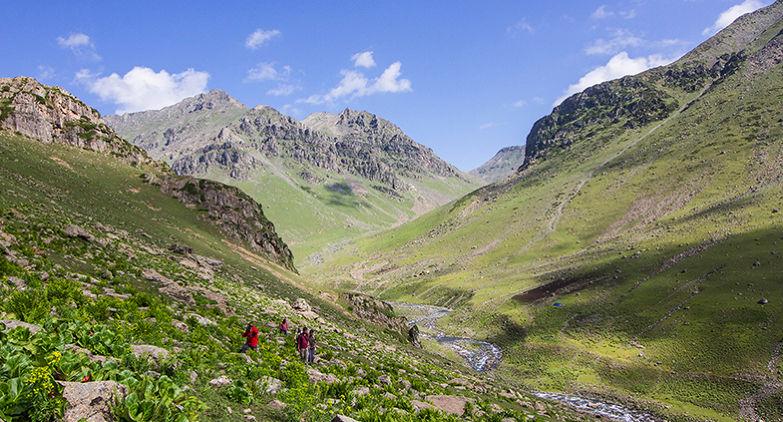Tarsar Marsar: One of India's most beautiful treks

The Kashmir Kolhoi Peak (5400m), which is the highest mountain peak in the world and is situated to the north of Basmai, is the highest mountain peak that the Tarsar Marsar Lakes trek passes through. The trek's routes span the Basmai and Sonmasti mountain passes, as well as several streams and vibrant meadows. One of the most picturesque trekking routes in the Himalayas is the trip from Sumbal in the Sind Valley to Aru in the Lidder Valley via the Sonmasti Pass. You will have lasting recollections of the panoramas and enthralling beauty of Tarsar Lake, Marsar Lake, and Sundarsar Lake. The panoramic views that meet you as you climb the top of mountain passes and the turquoise water of these high-altitude lakes that sparkle like a beautiful opal against the lush green of the mountain meadows are truly breathtaking.
Basmai, a cradle-shaped hanging valley in one of the most isolated regions of the Kashmir Himalayas, is located at an elevation of 4000 meters. It is located in Jammu and Kashmir's Ganderbal and Anantnag districts, shares a border with Zanskar on the other side, and is distinguished by the magnificent Kohlai peak. For nature enthusiasts and bird watchers, the valley surrounded by snow-capped hills and alpine forest flora is a pleasure. Hikers may come across trees of the Chir (Pine), Oak, Deodar, and Bhojpatra as well as numerous animal species when traveling towards Basmai Pass and Tarsar Marsar Lakes.
Expectations from the trek
The Tarsar Marsar Lakes Trek offers a chance to see how the Bakarwal, or shepherds, and locals live their everyday lives in some of the state's most isolated regions. With their constant friendliness and smiles, it is fascinating and heartwarming to watch them go about their daily lives on farms and in humble homes. Over six days, you will walk for an average of 6-7 hours (about 8 miles) each day, covering a total distance of about 50 kilometers. The trek's highest point is at a height of about 4000 meters. Near the Basmai Pass, the walk includes a few difficult ascents and descents, and you spend the entire four days above 10,000 feet. You will pass through valleys, expansive grasslands, breathtakingly beautiful alpine lakes, rivers, and streams, as well as snow-capped mountain passes, while on your adventure. As you approach the passes, there is a modest chance of windy conditions or rain during the day. On the upper camps, nighttime lows could reach 0 degrees.
The Astounding Campsites in Tarsar Marsar Trek
The most significant and ideal component of this trek is camping next to snow-fed alpine lakes, which is its initial high point. Additionally, observe how the sun's rays affect the lakes' changing hues. At the Tarsar and Sundersar campsites, you must not miss the mesmerizing sunset and sunrise views across the Lake. Explore the breathtaking clearings that follow the dense coniferous forests as well, and you might even see some Gujjar huts there.
Aru Base camp & Exotic Grasslands
The Tarsar Marsar trek's base camp, Aru, is a tiny picturesque village surrounded by beautiful grasslands. The community is well-known for its cottages, poplar trees, and a river that runs through its center. Trekkers are so warmly welcomed by the Aru villages that they almost always return to complete another journey. Meadows, rivers, streams, birds, animals, and flowers are just a few of Kashmir's natural features that draw tourists there. The Jammu and Kashmir valley, often known as the Taj of India, is nothing short of a paradise. Sundersar campground had previously traveled across extensive Jagmargi plains. Get awed by its beauty as a result of the vast grasslands being surrounded by mountains and a small rivulet flowing through the pristine valley that is bursting with vibrant flowers in shades of yellow, blue, and pink.
The best time for the trek
The Tarsar Marsar Lakes Trek is best accomplished between July and October. Around this time, Kashmir has light precipitation, making it the perfect time to see the lakes and meadows that are awash in all hues of green. This is a moderate hike that is a trekkers' dream from mid-June to September. A considerable snow cover in June also contributes to the virginal splendor of the valley! The average daily temperature is between 13 and 18 degrees, and the average nighttime temperature is between 1-3 degrees. The area gets a lot of snowfall in the winter, and because the passes, trails, and meadows are all covered in snow, it is too cold to go hiking.
The Tarsar Marsar trek is neither extremely difficult nor easy; it is in the intermediate range. However, if someone is physically fit and has the desire to trek then they can certainly complete it.
- Art
- Causes
- Crafts
- Dance
- Drinks
- Film
- Fitness
- Food
- Giochi
- Gardening
- Health
- Home
- Literature
- Music
- Networking
- Altre informazioni
- Party
- Religion
- Shopping
- Sports
- Theater
- Wellness
- IT, Cloud, Software and Technology


